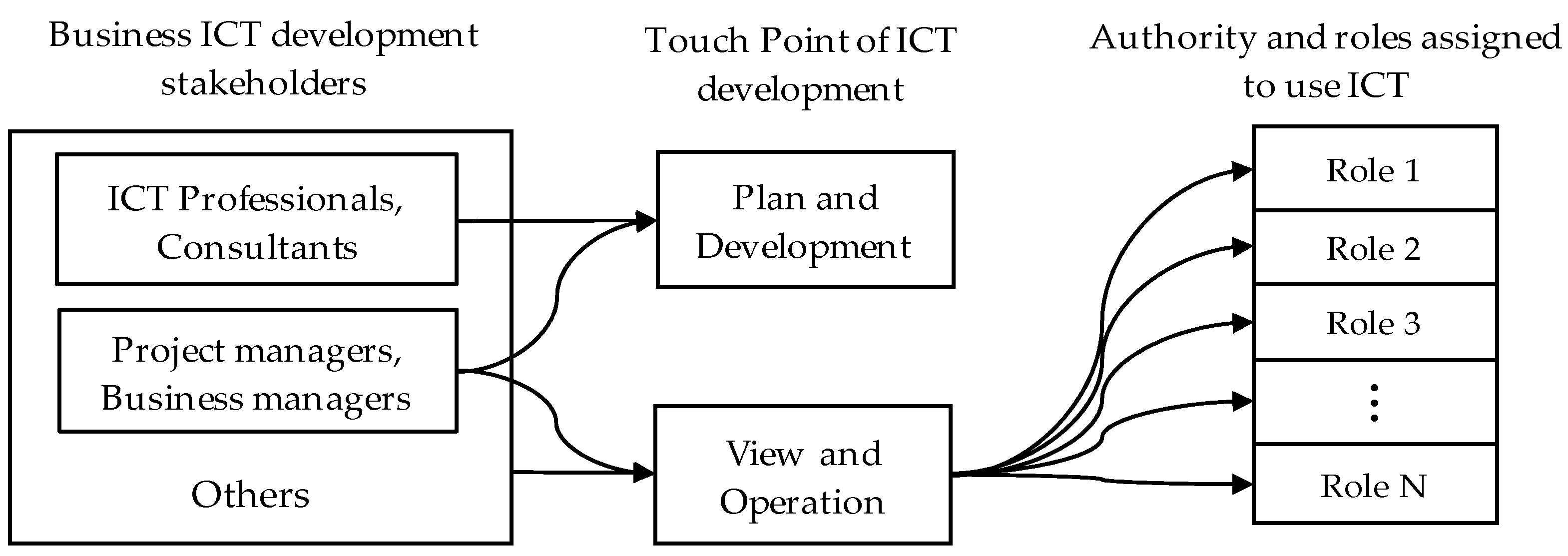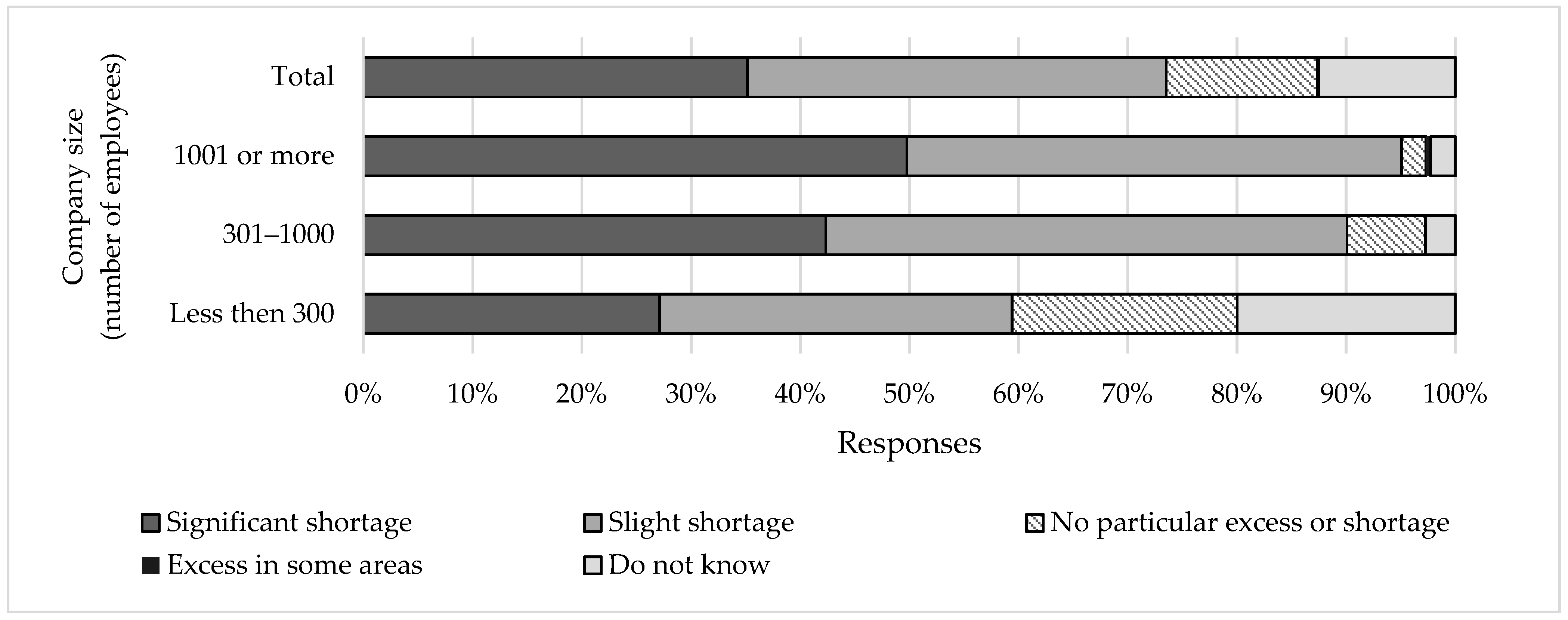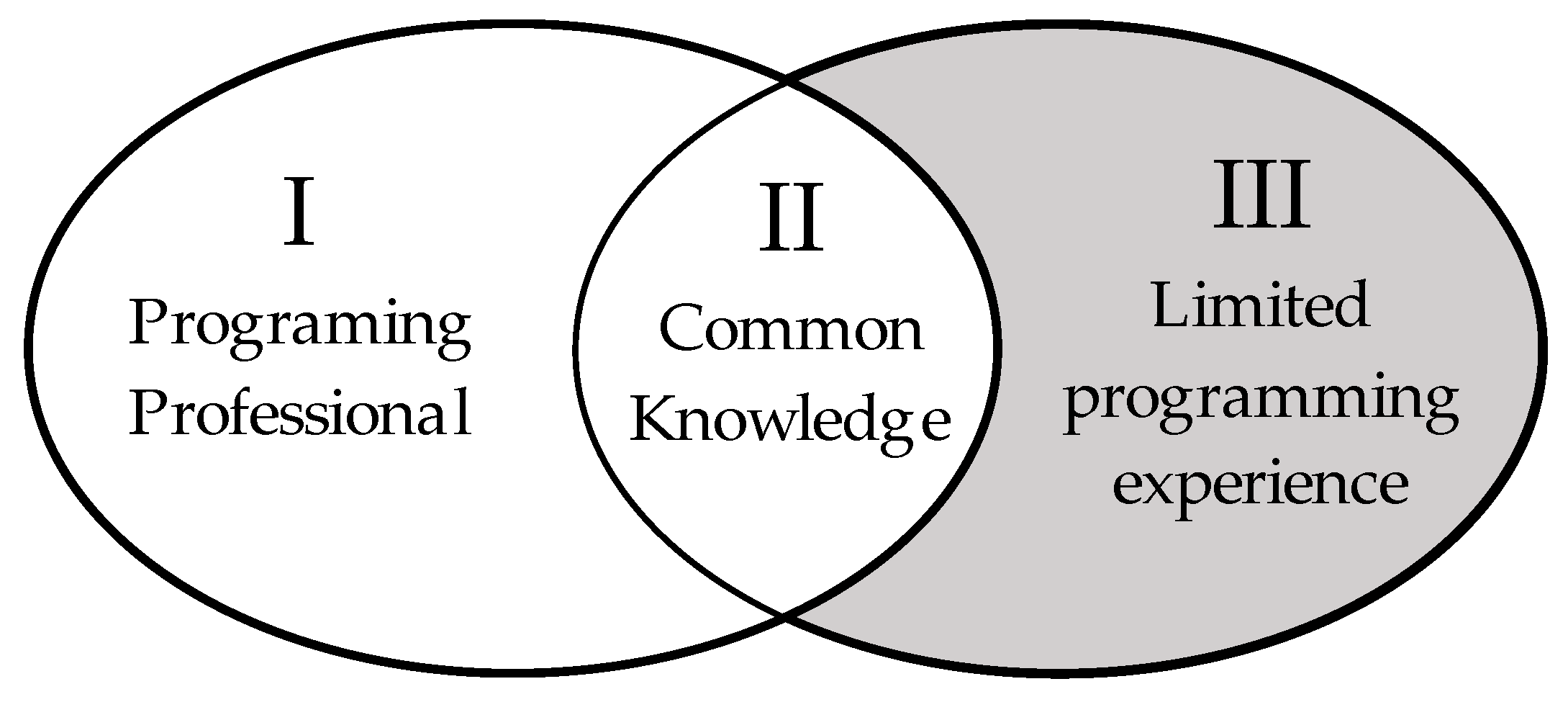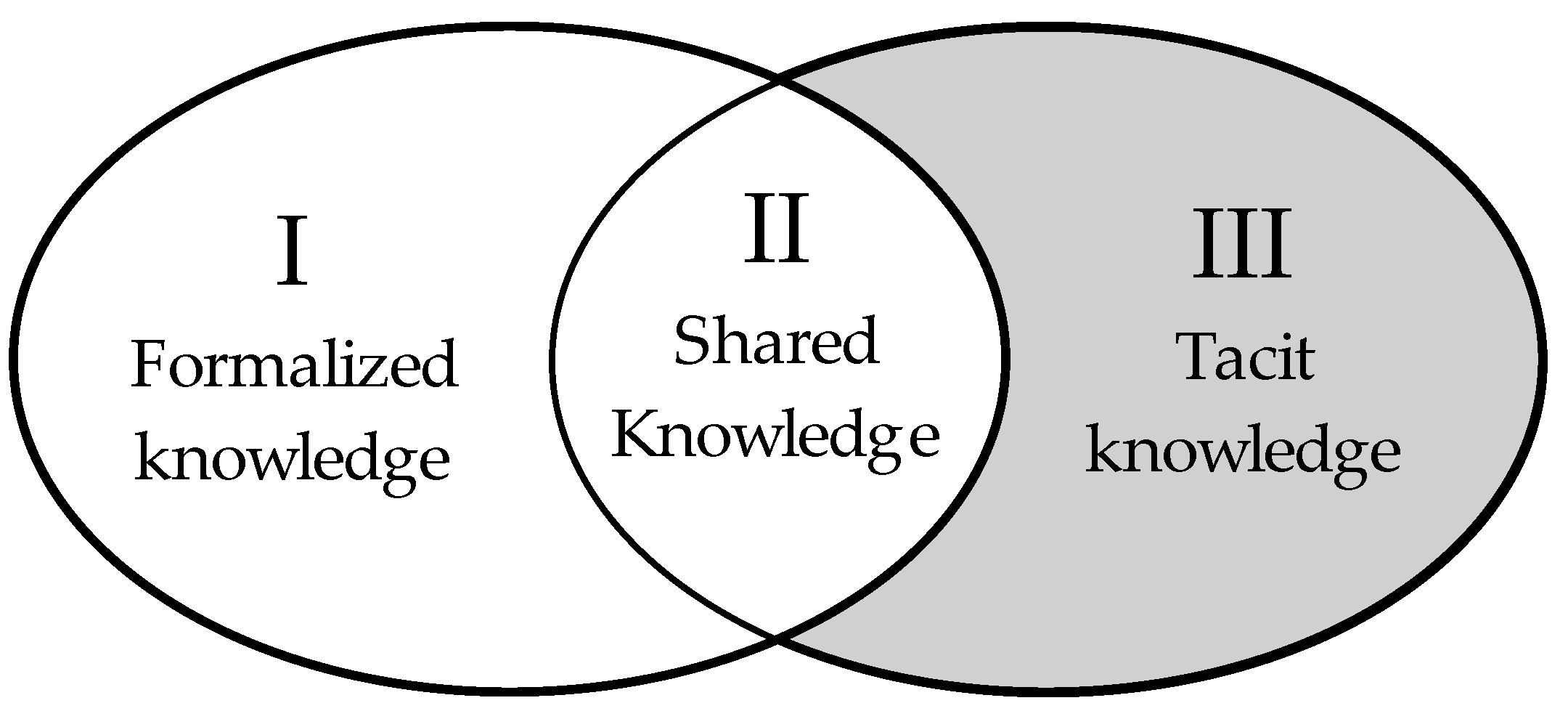How Low-Code Tools Contribute to Diversity, Equity, and Inclusion (DEI) in the Workplace: A Case Study of a Large Japanese Corporation
Abstract
:1. Introduction
1.1. Background and Problem Posed
1.2. Manuscript Structure
2. Literature Review
2.1. Diversity, Equity, and Inclusion Perspectives on Technology Use
2.2. Low-Code Development and Interactive Generative AI Tools
2.3. Advantages and Uniqueness of This Study
3. Research Methods
3.1. Purpose of This Study
3.2. Research Methods
3.3. Field of Study
4. Result: Result of Project Palette 1
4.1. Project 1 (Project Palette) Results (2021 End)
- (1)
- Prepare a memo explaining the procedure (personal);
- (2)
- Review content to improve and add information (group);
- (3)
- Creation of LCP applications (personal);
- (4)
- Review applications and post them on the portal (group).
4.2. Interviews for Project Palette 1 (2021 End)
4.3. Project Palette 1 Follow-Up Results (2023)
4.4. Summary of Project Palette 1
5. Comparison with Statistics
6. Discussion
6.1. Features of Low-Coding for DEI
6.2. What Are the Benefits of Low-Coding Perspective of SDGs
- (1)
- The native language is not English, and there are few English-speaking users.
- (2)
- Women’s participation in society lags behind that of other countries.
6.3. Integration of Legacy IT Systems and Low-Code Development
7. Answer to the Research Questions
7.1. Answer to RQ1
7.2. Answer to RQ2
8. Conclusions
Limitations and Future Development
Author Contributions
Funding
Institutional Review Board Statement
Informed Consent Statement
Data Availability Statement
Conflicts of Interest
References
- Heeks, R. Do information and communication technologies (ICTs) contribute to development? J. Int. Dev. 2010, 22, 625–640. [Google Scholar] [CrossRef]
- Christensen, K.; Doblhammer, G.; Rau, R.; Vaupel, J.W. Ageing populations: The challenges ahead. Lancet 2009, 374, 1196–1208. [Google Scholar] [CrossRef] [PubMed]
- Kramar, R. Beyond strategic human resource management: Is sustainable human resource management the next approach? Int. J. Hum. Resour. Manag. 2014, 25, 1069–1089. [Google Scholar] [CrossRef]
- Garg, S.; Sangwan, S. Literature review on diversity and inclusion at workplace, 2010–2017. Vision 2021, 25, 12–22. [Google Scholar] [CrossRef]
- Cunningham, G.B. The moderating effect of diversity strategy on the relationship between racial diversity and organizational performance. J. Appl. Soc. Psychol. 2009, 39, 1445–1460. [Google Scholar] [CrossRef]
- Bock, A.C.; Frank, U. Low-code platform. Bus. Inf. Syst. Eng. 2021, 63, 733–740. [Google Scholar] [CrossRef]
- Budhwar, P.; Chowdhury, S.; Wood, G.; Aguinis, H.; Bamber, G.J.; Beltran, J.R.; Boselie, P.; Lee Cooke, F.; Decker, S.; DeNisi, A.; et al. Human resource management in the age of generative artificial intelligence: Perspectives and research directions on ChatGPT. Hum. Resour. Manag. J. 2023, 33, 606–659. [Google Scholar] [CrossRef]
- Warschauer, M.; Matuchniak, T. New technology and digital worlds: Analyzing evidence of equity in access, use, and outcomes. Rev. Res. Educ. 2010, 34, 179–225. [Google Scholar] [CrossRef]
- Day, A.; Paquet, S.; Scott, N.; Hambley, L. Perceived information and communication technology (ICT) demands on employee outcomes: The moderating effect of organizational ICT support. J. Occup. Health Psychol. 2012, 17, 473–491. [Google Scholar] [CrossRef]
- Klaus, H.; Rosemann, M.; Gable, G.G. What is ERP? Inf. Syst. Front. 2000, 2, 141–162. [Google Scholar] [CrossRef]
- Ahmad, S.; Schroeder, R.G. The impact of human resource management practices on operational performance: Recognizing country and industry differences. J. Oper. Manag. 2003, 21, 19–43. [Google Scholar] [CrossRef]
- Anand, R.; Winters, M.F. A retrospective view of corporate diversity training from 1964 to the present. Acad. Manag. Learn. Educ. 2008, 7, 356–372. [Google Scholar] [CrossRef]
- Shani, A.B.; Noumair, D.A. (Eds.) Research in Organizational Change and Development; Emerald Publishing Limited: Bingley, UK, 2021. [Google Scholar]
- Diener, E. Subjective well-being. Psychol. Bull. 1984, 95, 542–575. [Google Scholar] [CrossRef] [PubMed]
- Oswick, C.; Noon, M. Discourses of diversity, equality, and inclusion: Trenchant formulations or transient fashions? Br. J. Manag. 2014, 25, 23–39. [Google Scholar] [CrossRef]
- Herring, C. Does diversity pay?: Race, gender, and the business case for diversity. Am. Sociol. Rev. 2009, 74, 208–224. [Google Scholar] [CrossRef]
- Jackson, S.E.; Joshi, A.; Erhardt, N.L. Recent research on team and organizational diversity: SWOT analysis and implications. J. Manag. 2003, 29, 801–830. [Google Scholar] [CrossRef]
- Jackson, S.E.; Schuler, R.S. Understanding human resource management in the context of organizations and their environments. Annu. Rev. Psychol. 1995, 46, 237–264. [Google Scholar] [CrossRef] [PubMed]
- Jehn, K.A.; Northcraft, G.B.; Neale, M.A. Why differences make a difference: A field study of diversity, conflict, and performance in workgroups. Admin. Sci. Q. 1999, 44, 741–763. [Google Scholar] [CrossRef]
- Jehn, K.A. Diversity, conflict, and team performances summary of program of research. Perform. Improv. Q. 1999, 12, 6–19. [Google Scholar] [CrossRef]
- Ely, R.J.; Thomas, D.A. Cultural diversity at work: The effects of diversity perspectives on work group processes and outcomes. Admin. Sci. Q. 2001, 46, 229–273. [Google Scholar] [CrossRef]
- Jackson, S.E.; Ruderman, M.N. Diversity in Work Teams: Research Paradigms for a Changing Workplace; American Psychological Association: Washington, DC, USA, 1995; p. xv-271. [Google Scholar]
- Cox, T.H.; Blake, S. Managing cultural diversity: Implications for organizational competitiveness. Acad. Manag. Perspect. 1991, 5, 45–56. [Google Scholar] [CrossRef]
- Köllen, T. Diversity management: A critical review and agenda for the future. J. Manag. Inq. 2021, 30, 259–272. [Google Scholar] [CrossRef]
- Arsel, Z.; Crockett, D.; Scott, M.L. Diversity, equity, and inclusion (DEI) in the Journal of Consumer Research: A curation and research agenda. J. Con. Res. 2022, 48, 920–933. [Google Scholar] [CrossRef]
- Ferraro, C.; Hemsley, A.; Sands, S. Embracing diversity, equity, and inclusion (DEI): Considerations and opportunities for brand managers. Bus. Horiz. 2023, 66, 463–479. [Google Scholar] [CrossRef]
- Van Dijk, J.; Hacker, K. The digital divide as a complex and dynamic phenomenon. Inf. Soc. 2003, 19, 315–326. [Google Scholar] [CrossRef]
- Friemel, T.N. The digital divide has grown old: Determinants of a digital divide among seniors. New Media Soc. 2016, 18, 313–331. [Google Scholar] [CrossRef]
- Sanchis, R.; García-Perales, Ó.; Fraile, F.; Poler, R. Low-code as enabler of digital transformation in manufacturing industry. Appl. Sci. 2019, 10, 12. [Google Scholar] [CrossRef]
- Waszkowski, R. Low-code platform for automating business processes in manufacturing. IFAC PapersOnLine 2019, 52, 376–381. [Google Scholar] [CrossRef]
- Wang, S.; Wang, H. A teaching module of no-code business app development. J. Inf. Syst. Educ. 2021, 32, 1. [Google Scholar]
- Bhattacharyya, S.S.; Kumar, S. Study of deployment of “low code no code” applications toward improving digitization of supply chain management. J. Sci. Technol. Policy Manag. 2021, 14, 271–287. [Google Scholar] [CrossRef]
- Chang, Y.-H.; Ko, C.-B. A study on the design of low-code and no code platform for mobile application development. Int. J. Adv. Smart Converg. 2017, 6, 50–55. [Google Scholar]
- Pinho, D.; Aguiar, A.; Amaral, V. What about the usability in low-code platforms? A systematic literature review. Comput. Lang. 2023, 74, 101185. [Google Scholar] [CrossRef]
- Lund, B.D.; Wang, T. Chatting about ChatGPT: How may AI and GPT impact academia and libraries? LHTN 2023, 40, 26–29. [Google Scholar] [CrossRef]
- Baİdoo-anu, D.; Owusu Ansah, L.O. Education in the era of generative artificial intelligence (AI): Understanding the potential benefits of ChatGPT in promoting teaching and learning. J. Ai 2023, 7, 52–62. [Google Scholar] [CrossRef]
- Brynjolfsson, E.; Li, D.; Raymond, L.R. Generative AI at work. In SSRN Journal; No. w.31161; National Bureau of Economic Research: Cambridge, MA, USA, 2023. [Google Scholar] [CrossRef]
- Noy, S.; Zhang, W. Experimental evidence on the productivity effects of generative artificial intelligence. Science 2023, 381, 187–192. [Google Scholar] [CrossRef]
- World Economic Forum. Global Gender Gap Report; World Economic Forum: New York, NY, USA, 2023. [Google Scholar]
- Hislop, D.; Bosua, R.; Helms, R. Knowledge Management in Organizations: A Critical Introduction; Oxford University Press: Oxford, UK, 2018. [Google Scholar]
- Huber, G.P. A theory of the effects of advanced information technologies on organizational design, intelligence, and decision making. Acad. Manag. Rev. 1990, 15, 47–71. [Google Scholar] [CrossRef]
- Nonaka, I.; Toyama, R.; Konno, N. SECI, Ba and leadership: A Unified Model of dynamic knowledge creation. Long Range Plann. 2000, 33, 5–34. [Google Scholar] [CrossRef]
- Alavi, M.; Leidner, D. Knowledge management systems: Issues, challenges, and benefits. Commun. Assoc. Inf. Syst. 1999, 1, 1–28. [Google Scholar] [CrossRef]
- Rossi, C.; Cricelli, L.; Grimaldi, M.; Greco, M. The strategic assessment of intellectual capital assets: An application within Terradue Srl. J. Bus. Res. 2016, 69, 1598–1603. [Google Scholar] [CrossRef]
- IPA (Information-Technology Promotion Agency, Japan). Survey on Skill Transformation in the Digital Age (FY2021); IPA: Tokyo, Japan, 2022. [Google Scholar]
- Nonaka, I.; Takeuchi, H. The Knowledge-Creating Company: How Japanese Companies Create the Dynamics of Innovation; Oxford University Press: New York, NY, USA, 1995. [Google Scholar]
- Chen, M.; Tan, Y. SF-FWA: A Self-Adaptive Fast Fireworks Algorithm for effective large-scale optimization. Swarm Evol. Comput. 2023, 80, 101314. [Google Scholar] [CrossRef]
- Singh, E.; Pillay, N. A study of ant-based pheromone spaces for generation constructive hyper-heuristics. Swarm Evol. Comput. 2022, 72, 101095. [Google Scholar] [CrossRef]






| Stage | Description | Count of Knowledge Units |
|---|---|---|
| Workshop Start | Before framework no knowledge formalized | 0 |
| First iteration | Original number of knowledge units shared by individuals at first | 223 |
| Second iteration | The number of knowledge units after refined by team members | 127 |
| Workshop End | The number of knowledge units released as an application | 94 |
| Group Member | A | B | C | D | E | F | G | H |
|---|---|---|---|---|---|---|---|---|
| Work experience (2021) Rounded to nearest 5 years | 20 | 20 | 10 | 5 | 5 | 20 | 20 | 25 |
| Job (2021–2023) | Assistant | Admin Staff | ||||||
| ICT development or programing experience | No | No | Yes | No | No | No | No | Yes |
| LCP Usage Status: Before project start (2021) | I | I | I | I | I | I | I | I |
| LCP Usage Status: At project completion (2021) | II | II | III | III | II | II | III | III |
| LCP Usage Status: Follow-up observation (2023) | II | III | - | III | II | III | III | III |
| Question: Do you want to learn programming? (2023) | No | Yes | - | Yes | No | Yes | No | No |
| Question: Do you want to use AI tools in your work? (2023) | Yes | Yes | - | Yes | Yes | Yes | Yes | Yes |
Disclaimer/Publisher’s Note: The statements, opinions and data contained in all publications are solely those of the individual author(s) and contributor(s) and not of MDPI and/or the editor(s). MDPI and/or the editor(s) disclaim responsibility for any injury to people or property resulting from any ideas, methods, instructions or products referred to in the content. |
© 2024 by the authors. Licensee MDPI, Basel, Switzerland. This article is an open access article distributed under the terms and conditions of the Creative Commons Attribution (CC BY) license (https://creativecommons.org/licenses/by/4.0/).
Share and Cite
Takahashi, N.; Javed, A.; Kohda, Y. How Low-Code Tools Contribute to Diversity, Equity, and Inclusion (DEI) in the Workplace: A Case Study of a Large Japanese Corporation. Sustainability 2024, 16, 5327. https://doi.org/10.3390/su16135327
Takahashi N, Javed A, Kohda Y. How Low-Code Tools Contribute to Diversity, Equity, and Inclusion (DEI) in the Workplace: A Case Study of a Large Japanese Corporation. Sustainability. 2024; 16(13):5327. https://doi.org/10.3390/su16135327
Chicago/Turabian StyleTakahashi, Natsumi, Amna Javed, and Youji Kohda. 2024. "How Low-Code Tools Contribute to Diversity, Equity, and Inclusion (DEI) in the Workplace: A Case Study of a Large Japanese Corporation" Sustainability 16, no. 13: 5327. https://doi.org/10.3390/su16135327
APA StyleTakahashi, N., Javed, A., & Kohda, Y. (2024). How Low-Code Tools Contribute to Diversity, Equity, and Inclusion (DEI) in the Workplace: A Case Study of a Large Japanese Corporation. Sustainability, 16(13), 5327. https://doi.org/10.3390/su16135327






